Chest X-Ray For Students: How to Interpret and Present Methodically.
Introduction
An exciting blog for students who struggle to interpret or present chest x-rays methodically on the ward. The DRS ABCDE (inspired from Life in the Fastlane) is an easy and meticulous method to provide relevant information on what you see and become confident in yourself and your interpretation. This method helps inexperienced students as it reduces the odds to miss anything on a chest x-ray. I definitely needed this and I still refer to this method whenever I look at chest x-rays.
Chest x-ray background
The x-ray was discovered by German scientist Wilhelm Conrad Röntgen on the 8th of November, 1895. He named it x-radiation to signify an unknown type of radiation and later took an x-ray image of his wife’s hand. X-ray photons are a form of electromagnetic radiations and carry enough energy to ionize atoms and disrupt molecular bonds. This makes it a type of ionizing radiation, and therefore harmful to living tissue. However, medical imaging greatly outweighed the harm by the benefits of the examination. It is an excellent tool for evaluating symptoms, physical signs, and placements of specific equipment.
When looking at an x-ray, you may see a picture in white and black. That is due to different tissues absorbing different amount of radiation due to their density (absorbing capabilities), the thickness of the material and duration of the exposure. The denser the structure, the more white it will appear. The same goes for thicker structures, which may not be that dense, and may appear whiter as there are more tissues to go through. Short exposure time will show brighter films, whereas long exposure time will make everything darker (remember, it is a lot darker as more photons are going through due prolonged exposure making the film black).
Bone absorbs the most radiation, which appears white, compared to fat that absorbs less and air that absorbs almost nothing (which is why the lungs appear black). Depending on the amount of radiation coming out of the person, the photons will change the film at the detector plate to a white/black scale picture.
Figure 1: Demonstrate different colours for different tissues under normal exposure. From: Strong Medicine: How to Interpret a Chest X-Ray (Lesson 1 - An Introduction).
Method for chest x-ray interpretation
In medicine, it is vital to be methodological and consistent; that is why DRS ABCDE is an acronym to learn off by heart. Do not confuse this for the first aid response! This is an excellent method to approach a chest x-ray and transmit relevant information to any listeners and decrease the chance to miss anything. There is no one “best” system, so be comfortable with any approach you are familiar with, although the first thing that needs assessing is the film’s technical quality. Let us begin!
DRS ABCDE
D -Details
Do we have the right patient?
Date of birth?
Film date?
Film history to compare? They may have normal anatomy that was always present but may look suspicious on the x-ray.
Film type.
Figure 2: Demonstrates details of a fake patient and a reminder that chest x-rays are horizontally mirrored. From: Ollie Burton. Chest X Rays (CXR) Made Easy! - Learn in 10 Minutes!
R - Ripe image
R in itself stands for RIPE and looks at the quality of the image. Remember that a chest x-ray is horizontally mirrored, meaning the right-hand side represents the body's left area.
Rotation: did the x-ray hit the patient straight on? A straight x-ray is the norm, and ideally, the clavicles are equidistant from the spine. The spine processes should be roughly vertical.
Inspiration: how well did the patient breath? An adequate inspiratory effort expands the chest allowing greater visualization. 5-6 anterior ribs should be displayed with at least 9-10 posterior ribs. Sometimes in COPD patients, their lungs are hyper-inflated, where the anterior ribs may finally meet or “pierce” the diaphragm beyond the 6th rib. If the inspired volume is inadequate, then describe as a “reduced lung volume” and never “poor inspiratory effort”.
Picture/projection: do check the right/left markers on the image. Is this an anterior/posterior (AP) view or posterior/anterior (PA) view? This is important as the heart's size may differ, especially when seen in AP projections, which may present the heart as cardiomegaly-like whereas it should not. A lateral view can also occur and is useful, for example, in lobar pneumonia. Sometimes AP films occur as the patient is too unwell to leave their bed; hence a portable machine is brought in.
Exposure: is everything clear and detailed? Are the vertebrae visible behind the heart? Is there too much contrast meaning the heart is bright and the lungs very dark? Think of “toasts”. If it is underexposed, it is too white, and too dark if overexposed.
Below demonstrates how to assess an x-ray by using the RIPE method.
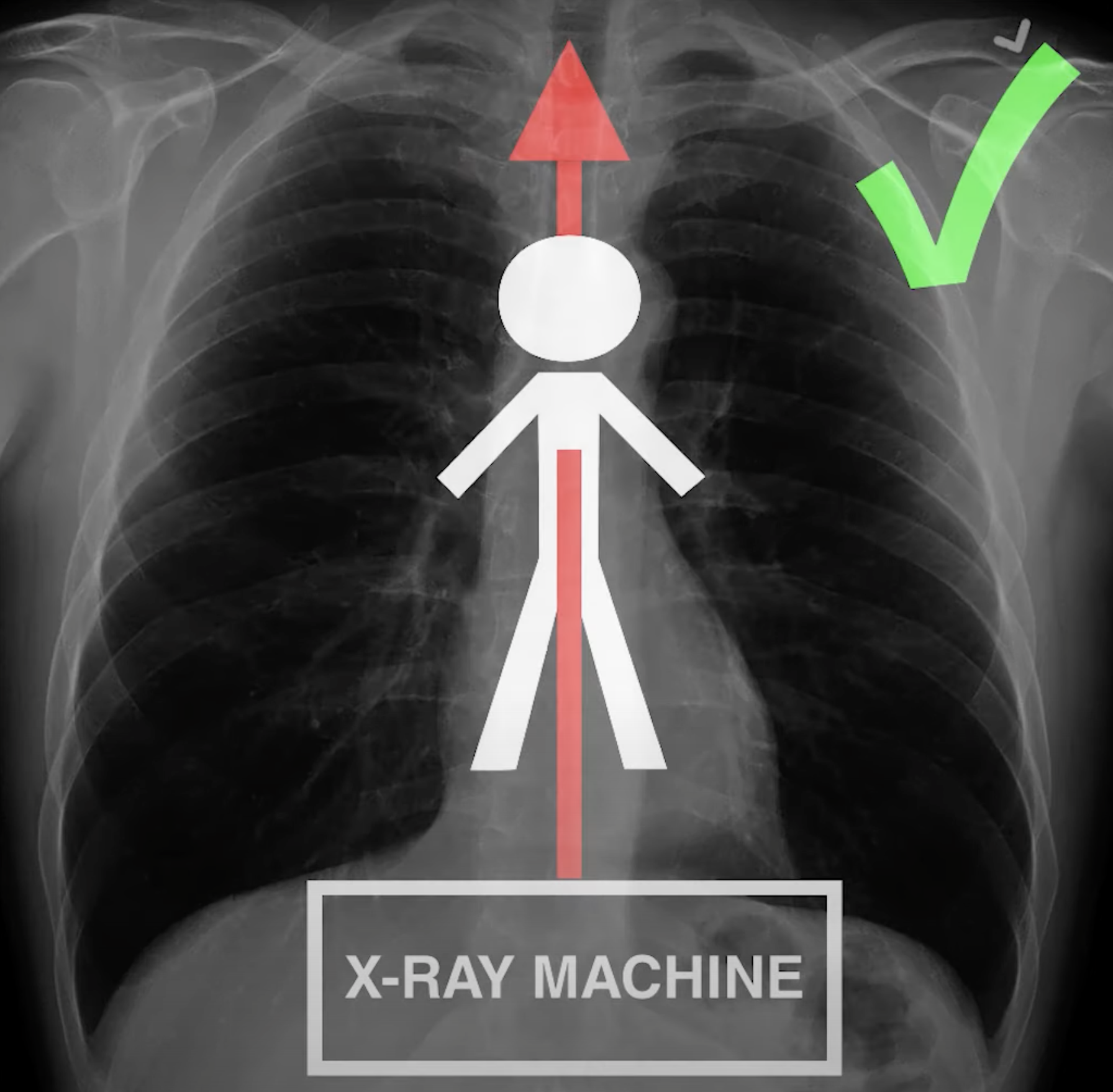
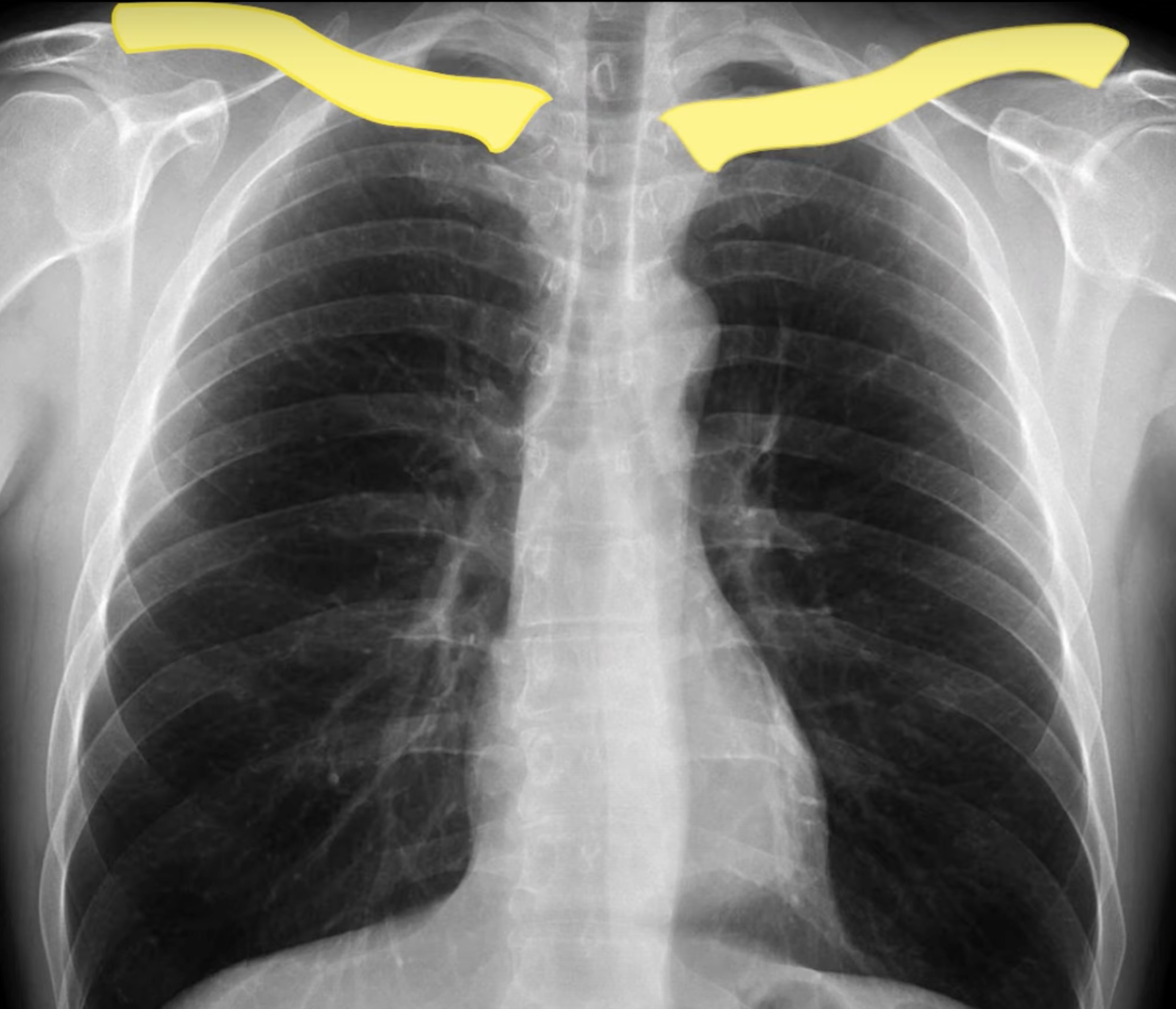
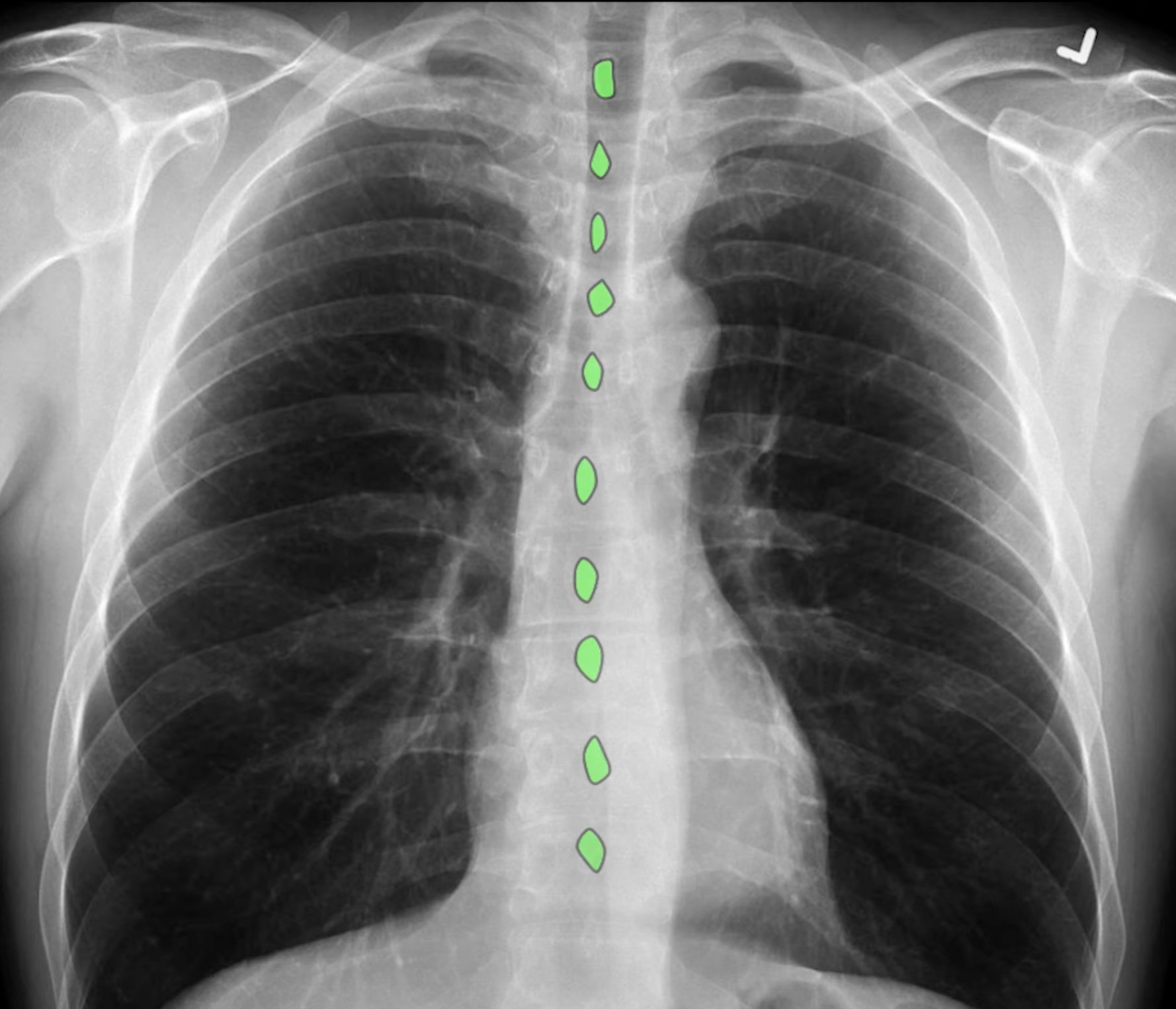
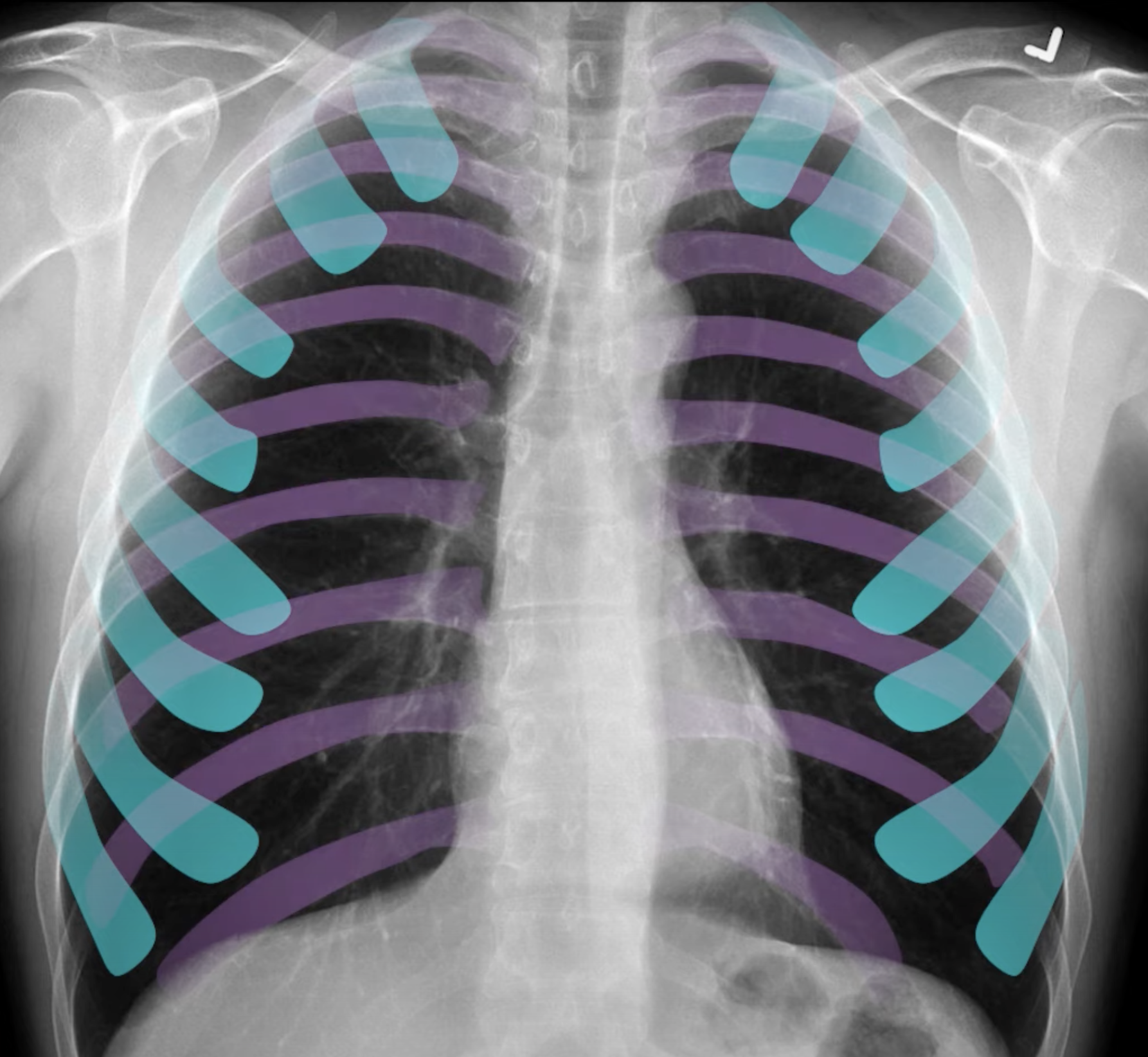
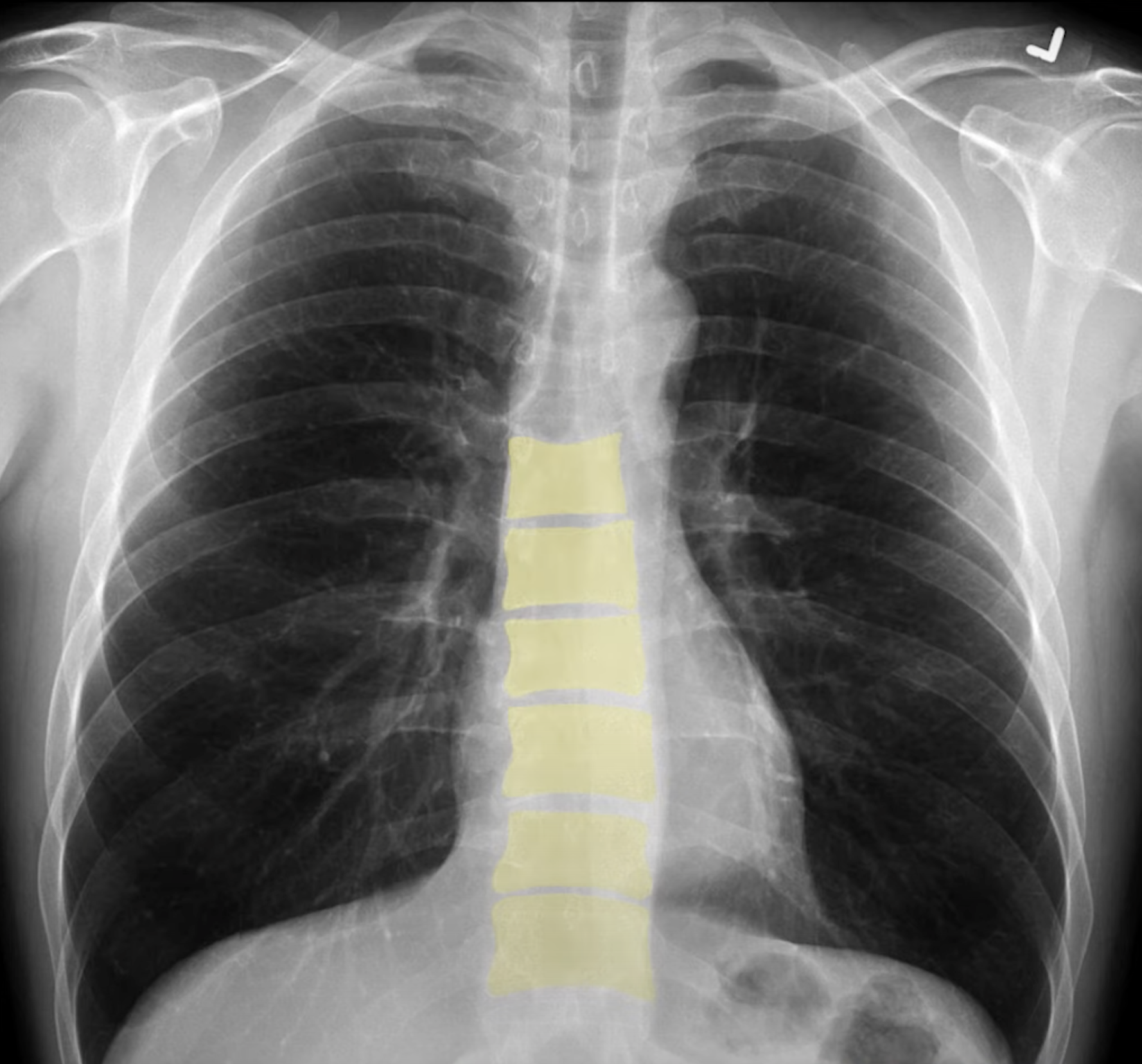
S - Soft tissues & bones
Bony involvement such as dislocation, fractures (old or new), rib notching or deformities (such as kyphosis, scoliosis or barrel chest).
Obvious soft tissue damage.
Air entrapment in places that should not be, such as subcutaneous emphysema.
Look at the anterior & posterior rib, clavicle, sternum (on lateral films) and the vertebral body.
Figure 3: Demonstrate the anatomy of the bones and their position on the x-ray. Strong Medicine. How to Interpret a Chest X-Ray (Lesson 2 - A Systematic Method and Anatomy).
A - Airway
The airway can be narrow, deviated or sometimes containing a foreign object. Is the trachea visible, and is it shifted to the left or right (such as from a tension pneumothorax or simply a spontaneous pneumothorax). The trachea is usually located centrally or just slightly to the right of the midline.
Notice the right and left bronchus and check the angle of carina. The right bronchus is broader and straighter/horizontal, making aspirated material more likely to go there. A tracheal tube may also end there if inserted too far.
Hilar regions. Are they abnormally enlarged or is there an unusual opacity? Lung cancers, such as squamous cell lung carcinomas or small cell lung cancer, can be seen in that region.
Look for the thumb sign (epiglottitis) or the steeple sign in croup.
Figure 4: Demonstrate the anatomy of the airways and its position on the x-ray. Strong Medicine. How to Interpret a Chest X-Ray (Lesson 2 - A Systematic Method and Anatomy).
B - Breathing
Lung field: look at the zones for any opacities such as the apex, upper, middle and lower zones. An example would be in lobar pneumonia, where sometimes you can even see the border of the lobes.
No lung markings may suggest a pneumothorax.
Pleura: not normally visible due to its thinness but do check for the lung markings that should extend to the edges of the lung field. Thick fibrotic layers can be indicative of mesothelioma.
Below demonstrates different lobes and areas of the lungs.


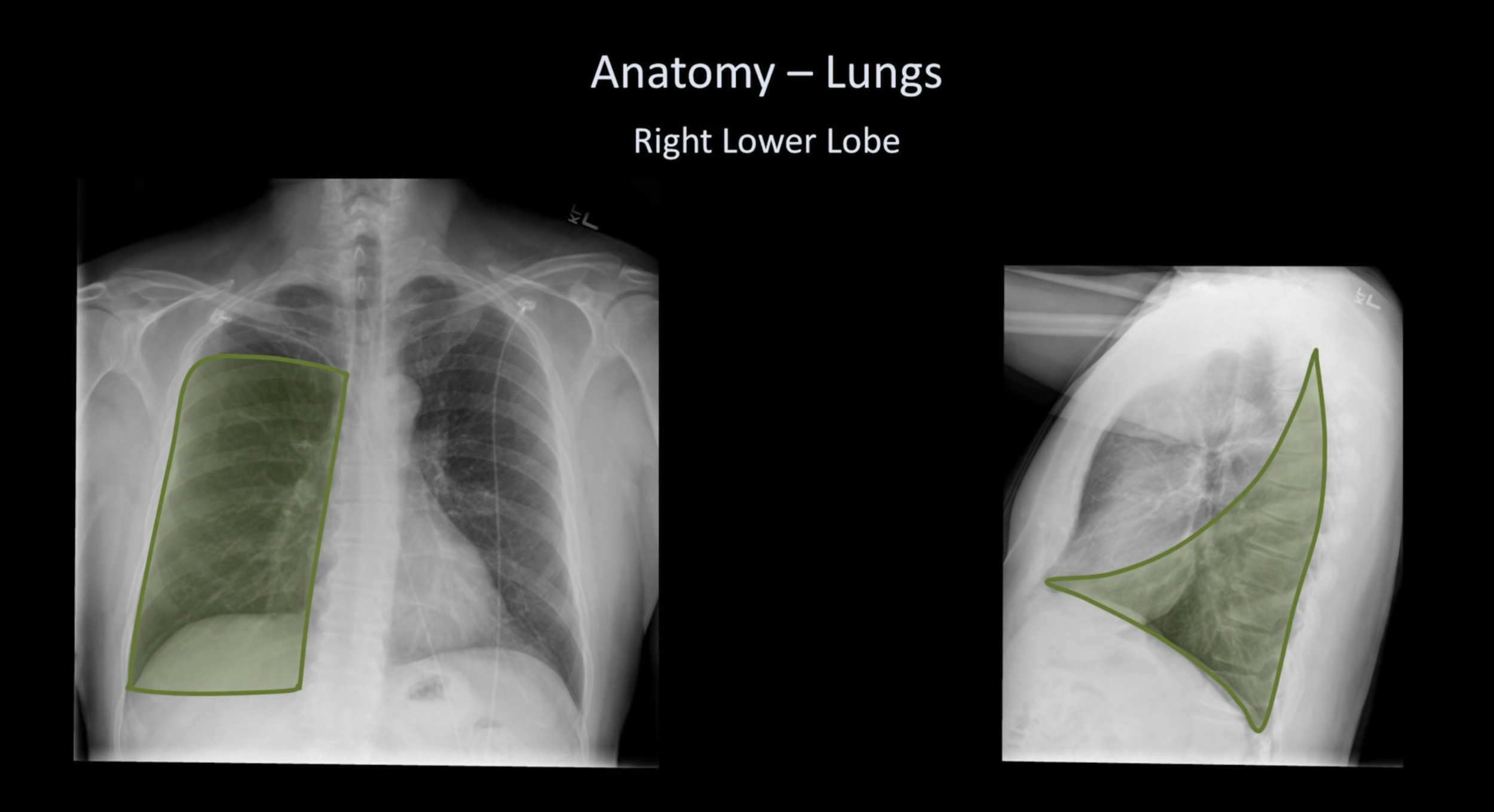
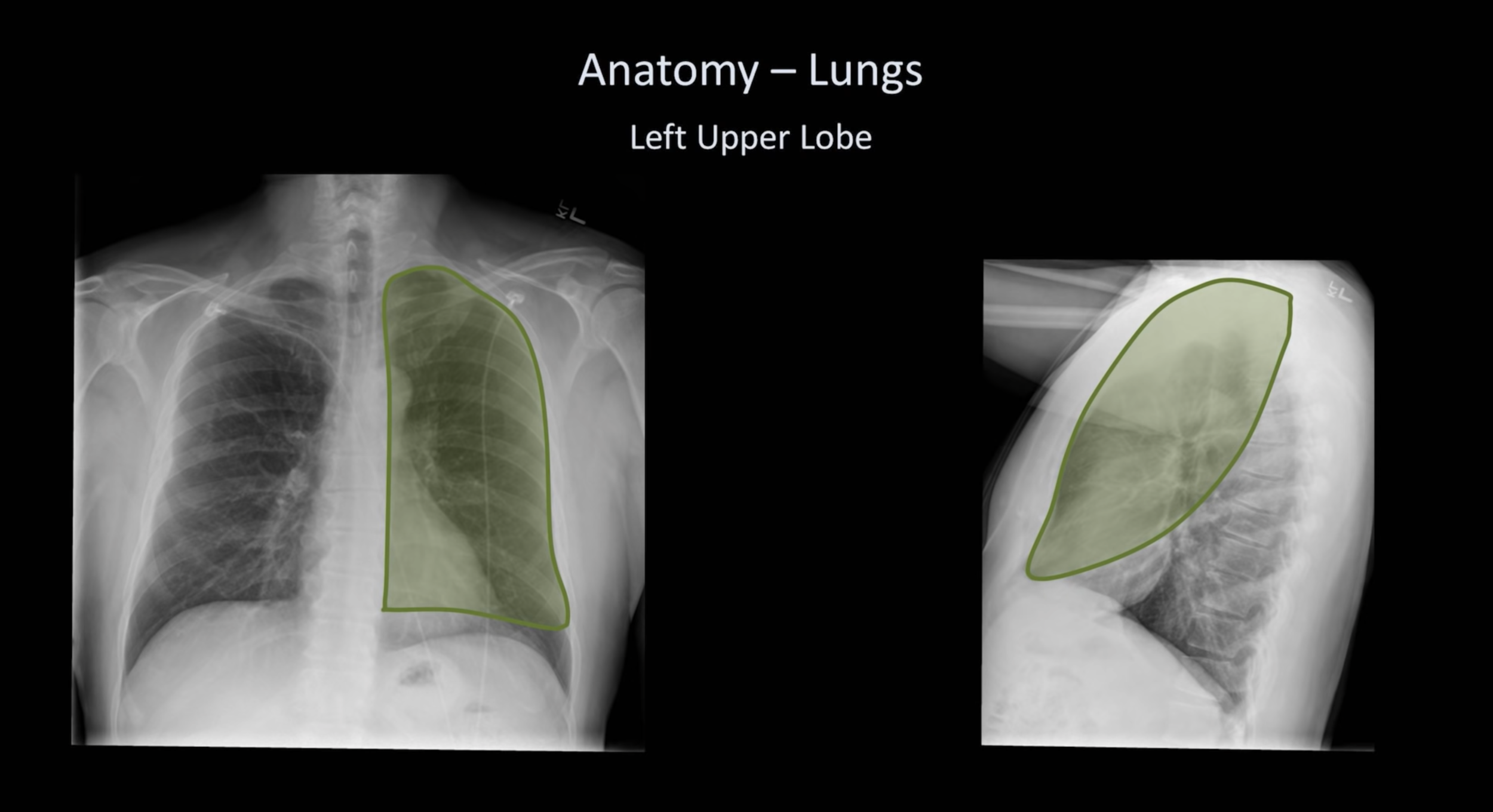
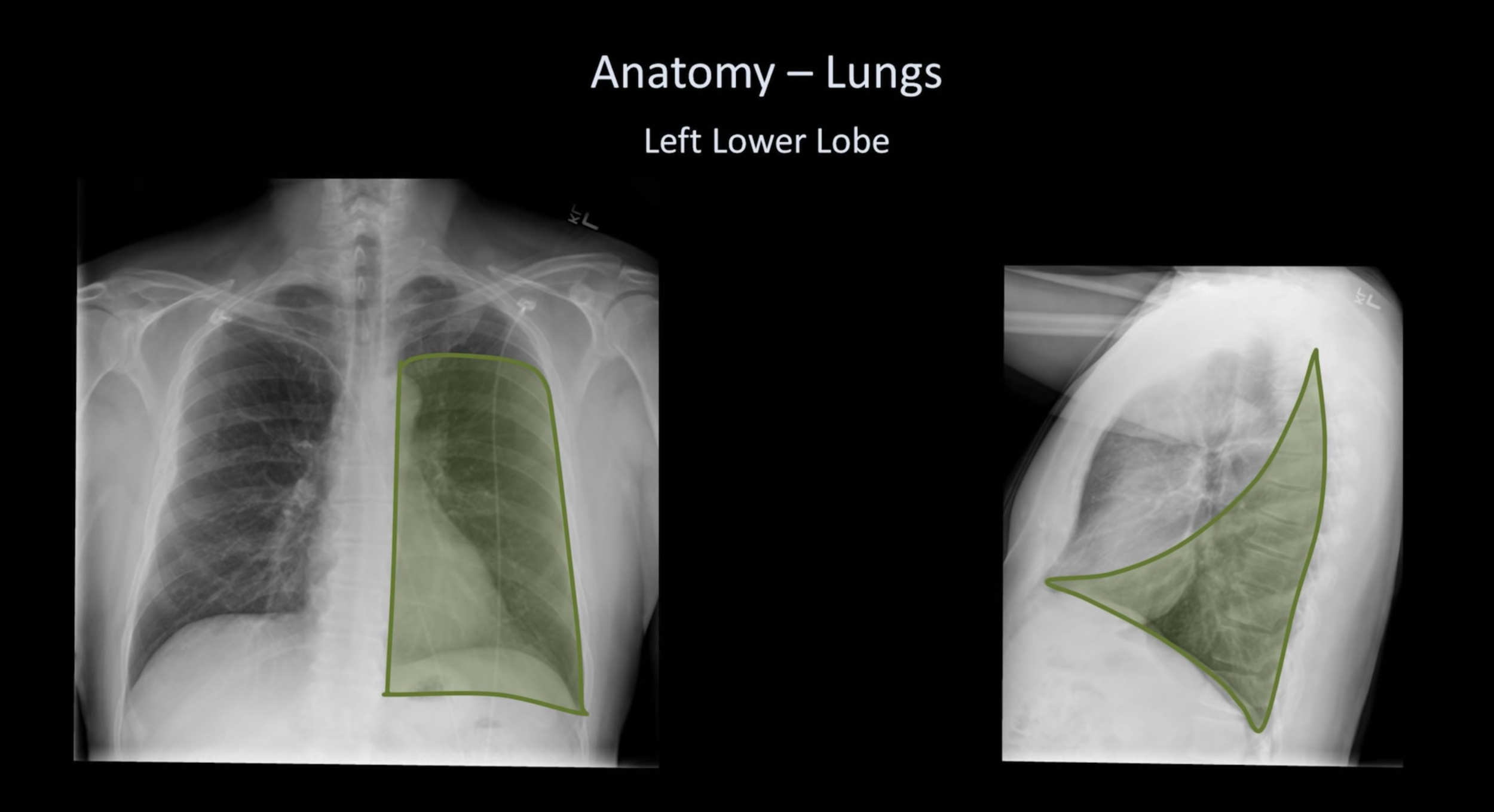
Figure 5: Demonstrates different areas of the lungs. From: Ollie Burton. Chest X Rays (CXR) Made Easy! - Learn in 10 Minutes!
C - Circulation & cardiac
Heart border: are there any silhouettes near the heart?
Heart position and shape.
Heart size: should be less than 50% of the thoracic window. If it is more than 50%, then it is indicative of cardiomegaly.
Figure 6: Demonstrate the heart silhouette and its position on the x-ray. Strong Medicine. How to Interpret a Chest X-Ray (Lesson 2 - A Systematic Method and Anatomy).
Figure 7: Demonstrate the anatomy of the heart and its position on the x-ray. Strong Medicine. How to Interpret a Chest X-Ray (Lesson 2 - A Systematic Method and Anatomy).
D - Diaphragm
Are there clear costophrenic angles? (where the diaphragm meets the ribs).
Is there fluid in this space from a pleural effusion? (fluid would appear as a meniscus, and you would lose that angle). Is it bilateral?
Is there a deep sulcus sign?
Is the diaphragm flattened? Remember, the right hemidiaphragm is higher than the left-hand side due to the presence of the liver. The diaphragm is not truly flat.
Under the left hemidiaphragm, you may notice a round dark patch representing gas in the stomach's fundus (or gastric bubble).
Figure 8: Demonstrate the pleura, hemidiaphragm and the costophrenic angles and its position on the x-ray. Strong Medicine. How to Interpret a Chest X-Ray (Lesson 2 - A Systematic Method and Anatomy).
E - Extras & everything else!
Central venous catheter (CVC) line, nasogastric tube, electrocardiogram electrodes, peripherally inserted central catheter line, chest tube, metalwork, pulmonary artery catheters, pacemaker.
Heart valves.
Buttons, piercings or a cigarette packet.
Sometimes hair clips/rings like in the movie Predator can be seen.
Typical chest x-ray markings
Figure 9: Normal chest x-ray layouts. From: A Line Drawing of AP Chest x-ray by Line drawings – #FOAMed Medical Education Resources by LITFL is licensed under a CC-BY-NC-SA 4.0 License.
Method to present
It is crucial to mention information that is relevant and in a logical flow. Report what you can see in an x-ray and the relevant positive findings. Say what you can see and your interpretation, remember the x-ray is there to help us understand what is going on, so not seeing anything is perfectly normal. Even if you have no idea, you can still do a great job in presenting the image (and getting marks).
Know about the patient as it may prompt you to see what you would expect and help you in a diagnosis. Do not skip steps and do not get biased when seeing a chest x-ray, especially from reading the history. Sometimes, you may see something evident and be tempted to jump quickly to the abnormality area. Try to avoid that situation as you may miss something that is somewhere else (what I am saying is don't blind yourself as the lung field generates the most significant interest in a chest x-ray, but did you notice that small fracture?). You will get to the abnormality eventually from the DRS ABCDE method.
The keywords are consistency and thoroughness.
Terminology to use
Radiolucent or lucency: a darker area on the image as relatively more of the administered x-rays reaching the detector.
Radiopaque or opacity: a whiter area on the image due to absorption of the x-rays prior to reaching the detector.
Consolidation: a process by which air in the lungs is replaced by-products of disease, rendering the lung more solid.
Nodule: opacity < 3 cm in diameter.
Mass: opacity > 3 cm in diameter.
Line: linear opacity < 2 mm in thickness.
Stripe: linear opacity 2 – 5 cm in thickness.
Hilum: singular, hila: plural and hilar: adjective.
Atelectasis: the collapse of the lung, either by being compressed by the outside or if an airway to the lung is obstructed.
Focal/diffuse/patchy: These terms are often found in a radiology report and describe a process in the lungs.
Silhouette sign: when two structures of different densities, like the lungs and heart, lie adjacent to each other and a visible border forms at the interface.
Case study: muck in the chest
Below is a case study with a made-up patient's details, along with a chest x-ray and relevant investigations. Look at the history, then the chest x-ray and comment under each section of the DRS ABCDE method. Practice your findings in front of a mirror or in front of someone you know well!
Patient history
A patient comes to the GP practice and presents with the following.
Presenting complaint: 52-year-old male presents with high fever, sweating, chills & rusty sputum for 4 days. The onset of the cough was abrupt. He mentions there is pain on his right-hand side of the chest. He struggles to breathe and finds that sitting down helps him a little and uses paracetamol for pain. He is worried and concerned that he has an infection.
Medication: has high blood pressure medications and is well controlled.
Vaccination: up to date and recently had the COVID-19 shot.
Past medical and surgical history: high blood pressure, no surgical history.
SNAP: he does smoke with a 3 pack-year history, eats relatively “well and healthy”, drinks alcohol at least 4 nights a week and has a physical job to which he describes as “his exercise”.
Social and family history: he is a truck driver, well supported by his family and has a family history of heart problems.
Vitals & examination
You take his vitals and do a respiration examination; the following was found.
Vitals: 38.4 degrees Celsius, 25 RR, 116 bpm, 02 sats are above 94%.
Respiration examination: alert, well orientated and can speak in full sentences. Dull percussion was heard on the right-hand side of the chest. Decreased breath sounds with crepitations heard on the right-hand side of the chest's anterior and posterior side. Tactical fremitus was increased on the right-hand side. No tracheal deviation and no use of accessory muscles. Nothing unusual at the hands, face and legs. Cardiovascular examination was unremarkable.
Investigations
Chest x-ray was taken, and below shows the result.
Blood test showed elevated white blood cells.
ECG, lactate and EUC were all in range.
Figure 9: Chest x-ray findings from the case study.
DRS ABCDE
Details
You have confirmed that you have the right patient and the right x-ray for this patient along with his details (52-year-old male, patient ID, DOB, name and when was the x-ray taken). No previous x-rays are available.
RIPE
The clavicles are equidistant and thus minimal rotation.
There is adequate inspiration effort as 6 anterior ribs can be seen. Costophrenic angles are visible on both sides.
This is a PA film, unfortunately there is no lateral view available.
The exposure is adequate as the vertebral bodies behind the heart can be slightly seen.
Soft tissues and bones
Appears normal.
Airways
Appears normal. No tracheal deviation, and it is difficult to assess the angle of the carina. Bronchi are challenging to visualize.
Breathing
The left lung looks normal, with no obvious consolidation or opacities. The right lung presents with a large well-defined opacity zone/consolidation at the right lower zone with loss of right heart border and maintenance of right hemidiaphragm. Without a lateral view, we cannot be 100% sure if this involves the middle or lower lobe. However, because there is no silhouette sign between the lung and the right hemidiaphragm, we can conclude the middle lobe involvement rather than the lower lobe. The pleura looks normal with no evidence of thickening. No loss of lung markings.
Circulation and cardiac
Cardiac silhouette is well defined and of normal size. Arch of the aorta can be visualized.
Diaphragm
Appears normal. No evidence of costophrenic blunting or fluid present. The fundus of the stomach can be seen on the left.
Extras
Nothing extra can be seen.
Diagnosis
With the combined history, vitals & examination, and the chest x-ray, we can conclude a right middle lobe pneumonia is the most probable diagnosis (lobar pneumonia/community acquired pneumonia). Management would be the next key step.
Published 30th January 2021. Last reviewed 1st December 2021.
Reference
Daniel Ward, Dr Lewis Potter. Chest X-ray (CXR) Interpretation. Geeky Medics website. https://geekymedics.com/chest-x-ray-interpretation-a-methodical-approach/. Updated Feb 25, 2021. Accessed January 5, 2021.
Fraser Brims. DRSABCDE of CXR Interpretation. Life in the Fastlane website. https://litfl.com/drsabcde-of-cxr-interpretation/. Published Nov 3, 2020. Accessed January 3, 2021.
Ollie Burton. Chest X Rays (CXR) Made Easy! - Learn in 10 Minutes! https://www.youtube.com/watch?v=3Ok6wIiu0zk. Published Nov 16, 2019. Accessed January 3, 2021.
Physio-pedia authors. X-Rays. Physiopedia website.
https://www.physio-pedia.com/X-Rays. Reviewed Mar 1, 2020. Accessed January 3, 2021.
Pressbooks authors. Approach to the Chest X-ray (CXR). Pressbooks website. https://undergradimaging.pressbooks.com/chapter/approach-to-the-chest-x-ray-cxr/. Accessed January 3, 2021.
Strong Medicine. How to Interpret a Chest X-Ray (Lesson 1 - An Introduction). https://www.youtube.com/watch?v=PDaRNPUNc10. Published Dec 18, 2013. Accessed January 3, 2021.
Strong Medicine. How to Interpret a Chest X-Ray (Lesson 2 - A Systematic Method and Anatomy). https://www.youtube.com/watch?v=L6bnD2wOEmg. Published Dec 19, 2013. Accessed January 3, 2021.
Strong Medicine. How to Interpret a Chest X-Ray (Lesson 4 - Airways, Bones, and Soft Tissues). https://www.youtube.com/watch?v=9J8rcmCVoes. Published Jan 7, 2014. Accessed January 3, 2021.





























